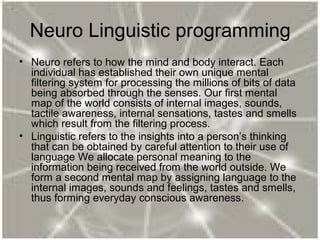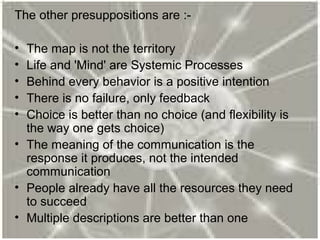Neuro linguistic programming
- 1. Neuro Linguistic programming Niharika Thakkar, M.A, N.E.T, MBPsS, Clinical Psychology
- 2. Neuro Linguistic programming • NLP is a system of alternative therapy based on this which seeks to educate people in self-awareness and effective communication, and to change their patterns of mental and emotional behaviour" • There ia theoretical connection between neurological processes ('neuro'), language ('linguistic') and behavioral patterns that have been learned through experience ('programming') and that can be organised to achieve specific goals in life • The behavioural response that occurs as a result of neurological filtering processes and the subsequent linguistic map.
- 3. Neuro Linguistic programming • Neuro refers to how the mind and body interact. Each individual has established their own unique mental filtering system for processing the millions of bits of data being absorbed through the senses. Our first mental map of the world consists of internal images, sounds, tactile awareness, internal sensations, tastes and smells which result from the filtering process. • Linguistic refers to the insights into a person’s thinking that can be obtained by careful attention to their use of language We allocate personal meaning to the information being received from the world outside. We form a second mental map by assigning language to the internal images, sounds and feelings, tastes and smells, thus forming everyday conscious awareness.
- 4. Models The models of neuro-linguistic programming are the techniques used to perform neuro-linguistic programming on a mind or person, and the methods used to teach those techniques to people
- 5. The Models • Internal ‘maps’ of the world • Representational system • Meta Model • Milton Model • Meta Programmes
- 6. Presuppositions-The map is not the territory As human beings, we can never know reality. We can only know our perceptions of reality. We experience and respond to the world around us primarily through our sensory representational systems. It is our 'neuro-linguistic' maps of reality that determine how we behave and that give those behaviors meaning, not reality itself. It is generally not reality that limits us or empowers us, but rather our map of reality.
- 7. The other presuppositions are :- • The map is not the territory • Life and 'Mind' are Systemic Processes • Behind every behavior is a positive intention • There is no failure, only feedback • Choice is better than no choice (and flexibility is the way one gets choice) • The meaning of the communication is the response it produces, not the intended communication • People already have all the resources they need to succeed • Multiple descriptions are better than one
- 8. Presuppositions-The map is not the territory Presuppositions are the internal, mental environmental structure we build that directs our conscious attention span. These presuppositions form the environment from which all NLP techniques take form
- 9. Forming A Map Of The World • The outer world is made up of sub atomic particles. • The outer world provides us with input. • Which is absorbed by our senses. • These inputs are filtered. • The filters are neurological and linguistic • After the absorption, an output in the form of speech or action or attitude or perspective is given.
- 13. Formation Of Negative Maps Each person's map of the world determines feelings and behavior. Therefore, impoverished - and unrealistic - maps can restrict choices and result in problems
- 14. NLP Therapy As an approach to personal development or therapy it involves understanding that people create their own internal 'map' or world, recognizing unhelpful or destructive patterns of thinking based on impoverished maps of the world, then modifying or replacing these patterns with more useful or helpful ones. There is also an emphasis on ways to change internal representations or maps of the world in order to increase behavioral flexibility
- 15. Benefits Of NLP You can • Acquire skills and attitudes, by accessing your inner resources, which enable you to run your life more successfully • Use your mind, your emotions and body more effectively by promoting harmony in the way the conscious and unconscious minds work together. • Break free of old patterns of behaviour and generate unlimited potential. • Change your thoughts, moods and behaviours. • Communicate more effectively e.g. in communication, therapy, sales, management, coaching, teaching etc. • Improve performance because it focuses on excellence, and identifies the key components of excellent performance. • Achieve good health by breaking free of any destructive thought patterns that spoil the quality of your life.
- 16. Usage There is no limitation on the areas in which NLP can successfully transform your current performance. The following are just examples: • Therapy – Stopping smoking, losing weight, dealing with fears and phobias, addressing panic/anxiety, depression, M.E., improving medical conditions which have an underlying emotional dimension etc • Business coaching – presentations, improving management and communication performance, sales, goal setting etc Personal coaching – improving confidence, addressing self esteem issues, overcoming negative attitudes and beliefs etc • Performance coaching – improve sport and business performance, increase creativity etc
- 17. Thank You
















